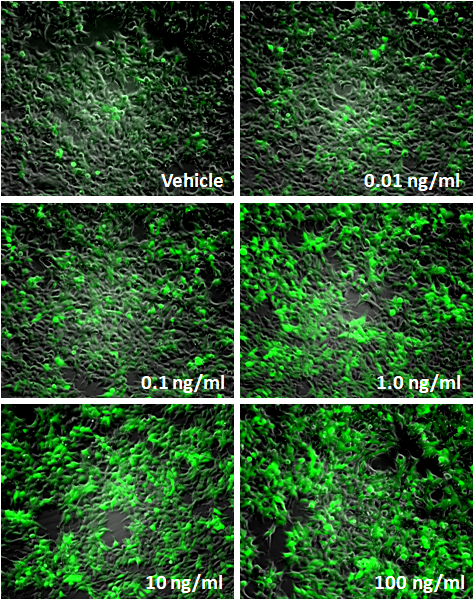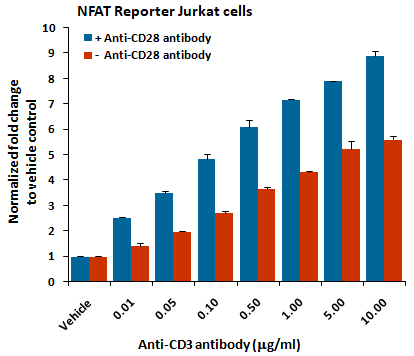Monoclonal Antibody to GAPDH (Clone: ABM22C5)

Figure-1: Western blot analysis of GAPDH. Anti- GAPDH antibody (Clone: ABM22C5) was used at 0.5 µg/ml on (1) Panc-1, (2) EL-4, (3) Jurkat and (4) HepG2 lysates.
Roll over image to zoom in
Shipping Info:
Order now and get it on Friday November 29, 2024
Same day delivery FREE on San Diego area orders placed by 1.00 PM
| Format : | Purified |
| Amount : | 100 µg |
| Isotype : | Mouse IgG1 Kappa |
| Purification : | Protein G Chromatography |
| Content : | 25 µg in 50 µl/100 µg in 200 µl PBS containing 0.05% BSA and 0.05% sodium azide. Sodium azide is highly toxic. |
| Storage condition : | Store the antibody at 4°C, stable for 6 months. For long-term storage, store at -20°C. Avoid repeated freeze and thaw cycles. |
GAPDH (Glyceraldehyde-3-Phosphate Dehydrogenase) is an enzyme best known for its role in glycolysis. However, extra-glycolytic functions of GAPDH have been described, including regulation of protein expression via RNA binding. GAPDH binds to numerous AREs (adenine-uridine rich elements) from various mRNA 3'-untranslated regions in vitro and in vivo despite its lack of a canonical RNA binding motif. GAPDH specifically catalyzes the simultaneous phosphorylation and oxidation of glyceraldehyde 3-phosphate using NAD+ (Nicotinamide Adenine Dinucleotide) as a cofactor to produce glycerate 1,3-biphosphate and NADH. In addition to its role in energy production, GAPDH has been implicated in many cellular processes including DNA repair tRNA export, membrane fusion and transport, endocytosis and nuclear membrane assembly, and cell death.
Western blot analysis: 0.5-2 µg/ml, Immunohistochemical analysis: 5 µg/ml
For Research Use Only. Not for use in diagnostic/therapeutics procedures.
1. Kakade PS, Budnar S, Kalraiya RD, Vaidya MM. Functional Implications of O-GlcNAcylation-dependent Phosphorylation at a Proximal Site on Keratin 18. J Biol Chem. 2016 Jun 3;291(23):12003-13. doi: 10.1074/jbc.M116.728717. Epub 2016 Apr 8. PubMed PMID: 27059955.
2. Rohit Shetty, Anupam Sharma, Natasha Pahuja, Priyanka Chevour, Neeraja Padmajan, Kamesh Dhamodaran, Chaitra Jayadev, Rudy M. M. A. Nuijts, Arkasubhra Ghosh, Jeyabalan Nallathambi. Oxidative stress induces dysregulated autophagy in corneal epithelium of keratoconus patients. PLoS One. 2017; 12(9): e0184628. Published online 2017 Sep 13. doi: 10.1371/journal.pone.0184628 PMCID: PMC5597215
3. Ashraf R, Hamidullah, Hasanain M, Pandey P, Maheshwari M, Singh LR, Siddiqui MQ, Konwar R, Sashidhara KV, Sarkar J. Coumarin-chalcone hybrid instigates DNA damage by minor groove binding and stabilizes p53 through post translational modifications. Sci Rep. 2017 Mar 28;7:45287. doi: 10.1038/srep45287. PubMed PMID: 28349922; PubMed Central PMCID: PMC5368660.
4. Kumar S, Singh U, Goswami C, Singru PS. Transient receptor potential vanilloid 5 (TRPV5), a highly Ca(2+) -selective TRP channel in the rat brain: relevance to neuroendocrine regulation. J Neuroendocrinol. 2017 Apr;29(4). doi: 10.1111/jne.12466. PubMed PMID: 28235149.
5. Sahay P, Rao A, Padhy D, Sarangi S, Das G, Reddy MM, Modak R. Functional Activity of Matrix Metalloproteinases 2 and 9 in Tears of Patients With Glaucoma. Invest Ophthalmol Vis Sci. 2017 May 1;58(6):BIO106-BIO113. doi: 10.1167/iovs.17-21723. PubMed PMID: 28586796.
6. Nayak TK, Mamidi P, Kumar A, Singh LP, Sahoo SS, Chattopadhyay S, Chattopadhyay S. Regulation of Viral Replication, Apoptosis and Pro-Inflammatory Responses by 17-AAG during Chikungunya Virus Infection in Macrophages. Viruses. 2017 Jan 6;9(1). pii: E3. doi: 10.3390/v9010003. PubMed PMID: 28067803; PubMed Central PMCID: PMC5294972.
7. Panigrahi B, Singh RK, Mishra S, Mandal D. Cyclic peptide-based nanostructures as efficient siRNA carriers. Artif Cells Nanomed Biotechnol. 2018 Oct 12:1-11. doi: 10.1080/21691401.2018.1511574. [Epub ahead of print] PubMed PMID: 30311806.
8. Chloroquine Protects Human Corneal Epithelial Cells from Desiccation Stress Induced Inflammation without Altering the Autophagy Flux. S Shivakumar, T Panigrahi, R Shetty, M Subramani, A Ghosh, N Jeyabalan. BioMed Research International, 2018.
9. Pandey P, Singh D, Hasanain M, Ashraf R, Maheshwari M, Choyal K, Singh A, Datta D, Kumar B, Sarkar J. 7-hydroxyfrullanolide, isolated from Sphaeranthus indicus, inhibits colorectal cancer cell growth by p53 dependent and independent mechanism. Carcinogenesis. 2018 Dec 8. doi: 10.1093/carcin/bgy176. [Epub ahead of print] PubMed PMID: 30535334.
10. Panigrahi B, Mishra S, Singh RK, Siddiqui N, Bal R, Mandal D. Peptide generated anisotropic gold nanoparticles as efficient siRNA vectors. Int J Pharm. 2019 May 30;563:198-207. doi: 10.1016/j.ijpharm.2019.04.007. Epub 2019 Apr 3. PubMed PMID: 30953762.
11. Anuja K, Chowdhury AR, Saha A, Roy S, Rath AK, Kar M, Banerjee B. Radiation-induced DNA damage response and resistance in colorectal cancer stem-like cells. Int J Radiat Biol. 2019 Jun;95(6):667-679. doi: 10.1080/09553002.2019.1580401. Epub 2019 Mar 20. PubMed PMID: 30753097.
12. Mishra S, Verma SS, Rai V, Awasthee N, Arya JS, Maiti KK, Gupta SC. Curcuma raktakanda Induces Apoptosis and Suppresses Migration in Cancer Cells: Role of Reactive Oxygen Species. Biomolecules. 2019 Apr 23;9(4). pii: E159. doi: 10.3390/biom9040159. PubMed PMID: 31018580; PubMed Central PMCID: PMC6523773.
13. Nayak TK, Mamidi P, Sahoo SS, Kumar PS, Mahish C, Chatterjee S, Subudhi BB, Chattopadhyay S, Chattopadhyay S. P38 and JNK Mitogen-Activated Protein Kinases Interact With Chikungunya Virus Non-structural Protein-2 and Regulate TNF Induction During Viral Infection in Macrophages. Front Immunol. 2019 Apr 12;10:786. doi: 10.3389/fimmu.2019.00786. eCollection 2019. PubMed PMID: 31031770; PubMed Central PMCID: PMC6473476.
14. Hayat B, Padhy B, Mohanty PP, Alone DP. Altered unfolded protein response and proteasome impairment in pseudoexfoliation pathogenesis. Exp Eye Res. 2019 Apr;181:197-207. doi: 10.1016/j.exer.2019.02.004. Epub 2019 Feb 7. PubMed PMID: 30738879.
15. Chaudhary P, Babu GS, Sobti RC, Gupta SK. HGF regulate HTR-8/SVneo trophoblastic cells migration/invasion under hypoxic conditions through increased HIF-1α expression via MAPK and PI3K pathways. J Cell Commun Signal. 2019 Jan 26. doi: 10.1007/s12079-019-00505-x. [Epub ahead of print] PubMed PMID: 30684191.
16. Singh O, Pradhan DR, Nagalakashmi B, Kumar S, Mitra S, Sagarkar S, Sakharkar AJ, Lechan RM, Singru PS. Thyrotropin-releasing hormone (TRH) in the brain and pituitary of the teleost, Clarias batrachus and its role in regulation of hypophysiotropic dopamine neurons. J Comp Neurol. 2019 Apr 15;527(6):1070-1101. doi: 10.1002/cne.24570. Epub 2018 Dec 28. PubMed PMID: 30370602.
17. Kokate SB, Dixit P, Das L, Rath S, Roy AD, Poirah I, Chakraborty D, Rout N, Singh SP, Bhattacharyya A. Acetylation-mediated Siah2 stabilization enhances PHD3 degradation in Helicobacter pylori-infected gastric epithelial cancer cells. FASEB J. 2018 Oct;32(10):5378-5389. doi: 10.1096/fj.201701344RRR. Epub 2018 Apr 24. PubMed PMID: 29688807.
18. Padhy B, Kapuganti RS, Hayat B, Mohanty PP, Alone DP. De novo variants in an extracellular matrix protein coding gene, fibulin-5 (FBLN5) are associated with pseudoexfoliation. Eur J Hum Genet. 2019 Jul 29. doi: 10.1038/s41431-019-0482-6. [Epub ahead of print] PubMed PMID: 31358954.
19. Pal D, Neha CV, Bhaduri U, Zenia Z, Dutta S, Chidambaram S, Rao MRS.
LncRNA Mrhl orchestrates differentiation programs in mouse embryonic stem cells through chromatin mediated regulation.
Stem Cell Res. 2021 May;53:102250. doi: 10.1016/j.scr.2021.102250. Epub 2021 Feb 16.
PMID: 33662735.
20. Sharma, Rahul et al.
EGF-mediated Golgi dynamics and cell migration require CARP2
Cell Reports, Volume 43, Issue 11, 114896
| Subcellular location: | Cytoplasm, Nucleus, Cytoplasm, Membrane, Cytoplasm |
| Post transnational modification: | Oxidative stress can promote the formation of high molecular weight disulfide-linked GAPDH aggregates, through a process called nucleocytoplasmic coagulation. Such aggregates can be observed in vivo in the affected tissues of patients with Alzheimer disease or alcoholic liver cirrhosis, or in cell cultures during necrosis. Oxidation at Met-46 may play a pivotal role in the formation of these insoluble structures. This modification has been detected in vitro following treatment with free radical donor (+/-)-(E)-4-ethyl-2-[(E)-hydroxyimino]-5-nitro-3-hexenamide. It has been proposed to destabilize nearby residues, increasing the likelihood of secondary oxidative damages, including oxidation of Tyr-45 and Met-105. This cascade of oxidations may augment GAPDH misfolding, leading to intermolecular disulfide cross-linking and aggregation. |
| BioGrid: | 108868. 233 interactions. |
|
There are currently no product reviews
|
























.png)














